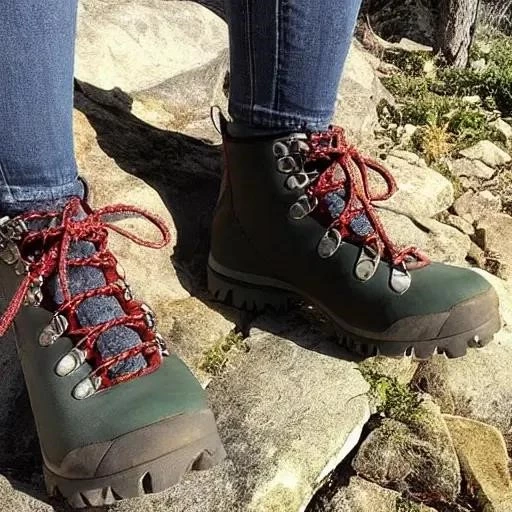Embarking on a wilderness journey, we meticulously plan our routes, pack our gear, and scrutinize every piece of equipment, from the backpack hugging our shoulders to the compass guiding our way․ Yet, an often-overlooked, surprisingly critical component of our hiking ensemble lies just beneath our gaze: the humble hiking boot laces․ Far more than mere strings, these slender strands are the unsung heroes defining comfort, stability, and ultimately, the safety of every single step we take on the trail․ Their length, material, and even the way they are tied can dramatically transform an arduous trek into an exhilarating exploration․
The quest for the perfect outdoor experience begins literally from the ground up, with our feet securely anchored within robust boots․ Ill-fitting or improperly chosen laces, however, can swiftly transform a promising expedition into a painful ordeal, leading to blisters, instability, and even dangerous falls․ Understanding the nuances of hiking boot laces, particularly their optimal length, is not merely a detail; it is a foundational element for both seasoned mountaineers and nascent nature enthusiasts alike․ This seemingly minor decision possesses the remarkable power to elevate your entire outdoor experience, ensuring every stride is confident and supported․
| Category | Description / Key Considerations | Typical Length Range (per boot) | Reference / Notes |
|---|---|---|---|
| Low-Cut Hiking Shoes (4-6 Eyelets) | Ideal for day hikes, lighter trails, or approaches where ankle support isn’t paramount․ Requires shorter laces for a snug fit without excessive slack․ | 45 ౼ 54 inches (114 ⎻ 137 cm) | Ensure laces are long enough to tie a secure double knot without excessive tail․ |
| Mid-Cut Hiking Boots (6-8 Eyelets) | The most common type, offering a balance of ankle support and flexibility for varied terrain․ Requires a moderate lace length to accommodate the extra height․ | 54 ⎻ 63 inches (137 ⎻ 160 cm) | Consider lacing techniques like heel-lock for improved fit and reduced slippage․ |
| High-Cut Hiking Boots (8+ Eyelets / Mountaineering) | Designed for rugged terrain, heavy loads, and challenging conditions, providing maximum ankle stability․ These require the longest laces․ | 63 ౼ 72 inches (160 ౼ 183 cm) or more | Extra length can be useful for specialized lacing patterns or wrapping around the ankle for added support․ |
| Lace Materials | Nylon: Durable, abrasion-resistant, good knot retention․ Polyester: Similar to nylon, often softer, good UV resistance․ Leather: Classic look, molds to boot, but can stretch and be less durable when wet․ Kevlar/Dyneema: Extremely strong, lightweight, minimal stretch, but can be expensive and sometimes slippery, requiring specific knot types․ | N/A | Material choice impacts durability, knot security, weight, and overall performance in various conditions․ |
| Lacing Techniques | Varying techniques (e․g․, surgeon’s knot, window lacing, heel lock, straight bar lacing) can optimize fit, relieve pressure points, and enhance performance and comfort․ | N/A | Experiment with different methods to find what works best for your specific foot shape, boot design, and activity․ |
So, how long are laces for hiking boots? The seemingly simple question unravels into a fascinating interplay of variables, demanding more than a one-size-fits-all answer․ Primarily, the height of your boot and the number of eyelets it features dictate the fundamental length required․ A low-cut hiking shoe with perhaps four to six eyelets will naturally demand a significantly shorter lace than a robust, high-cut mountaineering boot boasting eight or more pairs of eyelets․ Adding to this complexity are individual lacing preferences; some trekkers favor a snug, traditional crisscross, while others might employ specialized techniques like a heel-lock or window lacing to address specific pressure points or secure their foot more effectively within the boot․
Industry experts consistently emphasize the critical balance between adequate length and avoiding excessive slack․ “Too short, and you’re struggling to tie a secure knot, risking unraveling and potential falls,” explains Dr․ Eleanor Vance, a biomechanics specialist focusing on outdoor footwear․ “Too long, and you’re dealing with tripping hazards or cumbersome loops that can catch on brush․ It’s about finding that Goldilocks zone․” Generally, for low-cut hiking shoes (4-6 eyelets), laces typically range from 45 to 54 inches (114-137 cm)․ Mid-height boots (6-8 eyelets), the workhorses of most trails, often require 54 to 63 inches (137-160 cm)․ For the most demanding high-cut boots (8+ eyelets), lengths commonly extend from 63 to 72 inches (160-183 cm), sometimes even more for specialized mountaineering models․
Beyond mere length, the material composition of your laces plays an incredibly vital role in their performance and longevity․ Traditional nylon laces, renowned for their durability and excellent abrasion resistance, remain a popular choice, offering reliable knot retention even in challenging conditions․ Polyester variants provide similar robustness, often with improved UV resistance, making them ideal for sun-drenched trails․ For those seeking superior strength and minimal stretch, high-tech materials like Kevlar or Dyneema, frequently found in climbing ropes, are emerging as premium options, albeit at a higher cost․ These cutting-edge materials, expertly woven, promise enduring performance, keeping your feet securely anchored mile after strenuous mile․
Choosing the right length and material is just the beginning; mastering lacing techniques can further refine your boot’s fit, transforming a good pair of boots into an extension of your own body․ For instance, if you experience heel slippage, a “heel lock” lacing method, utilizing the top eyelets more strategically, can dramatically improve security․ Conversely, if you suffer from pressure points on the top of your foot, skipping an eyelet or employing “window lacing” in that specific area can provide much-needed relief․ By integrating insights from biomechanics and personal comfort, hikers are empowered to customize their footwear experience, mitigating common discomforts and maximizing their trail efficiency․
The journey doesn’t end when you purchase your laces; proper care and timely replacement are paramount to sustained performance․ Regularly inspecting your laces for fraying, thinning, or damage is a simple yet crucial preventive measure․ A worn-out lace, even if still functional, can snap unexpectedly, potentially leading to an awkward moment or, worse, a fall in uneven terrain․ Leading outdoor brands, such as those producing Salomon or Merrell boots, often recommend replacing laces annually for active users, or sooner if visible wear is present․ This proactive approach, ensuring your connection to the ground remains unbroken, underscores a commitment to safety and uninterrupted adventure․
Ultimately, the seemingly trivial question of “how long are laces for hiking boots” opens a gateway to a deeper appreciation of outdoor gear engineering and personal optimization․ From meticulously selecting the correct length based on boot height and eyelet count, to understanding the performance advantages of different materials, and finally, employing sophisticated lacing techniques, every decision contributes to a more secure, comfortable, and enjoyable trekking experience․ So, before your next great ascent, take a moment to truly assess your laces․ They are, after all, the silent guardians of your stride, poised to carry you confidently towards the horizon․






